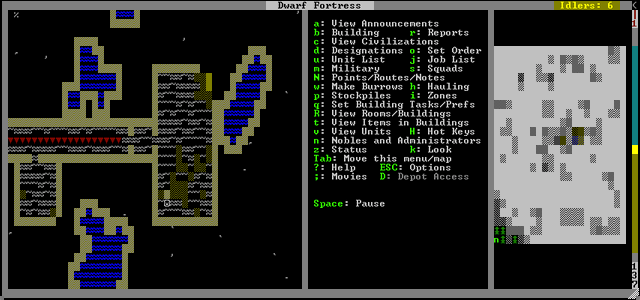
Fewer items inside a fort means fewer items to be stockpiled, checked for wear, and so on and so forth. However, in 3D it is still a large enough area for many fortresses in normal play. Keep in mind that a 2×2 embark is only 25% of the size of a 4×4 embark. Reducing the size of your embark site from the default 4×4 squares to 3×3 or even 2×2 will have an enormous impact on FPS. Larger embark sites dramatically increase the amount of terrain which DF needs to keep track of and path through. If you value your FPS, keep all of your doors pet-passable! Setting doors to be tightly closed causes pets to repath every time they try to enter them. You can generate a world without poles with a somewhat heightened temperature, or just embark somewhere which doesn't freeze over. Snow and ice melting can cause lag spikes. This generally also requires embarking in an area that isn't very close to an ocean or a mountain peak. Generating a world using a "REGION" template (instead of an "ISLAND" template which is used by "Create New World!") can significantly reduce the height of caverns and also place them closer together, resulting in fewer Z-levels. In general, the pathfinding algorithm will make a beeline to the right X and Y coordinates and then start floodfilling dumbly through the entire Z from there until it can find a way up, at which point the whole process repeats, so having fewer cavern tiles is better and open areas are to be avoided. Similarly, one could adjust Layer Openness and Layer Passage Density in advanced world generation to make the caverns have fewer tiles to path through. However, this will restrict access to subterranean plants and creatures, and reduce the number of spawned forgotten beasts. Adjusting the cavern layer number in advanced world generation parameters can reduce the number of cavern layers (default 3). Sometimes even trading caravans will try to path out of your fort underground. 
Creatures will repeatedly try to path into your fort from a cavern. Caverns can be an FPS hog due to pathfinding and how complex they can be.Reducing the number of civilizations, sites, beasts, and setting world population cap can limit the resources spent updating the rest of the world.Longer histories require more memory and storage space for historical figures and events.However, with how rich the game is with content, even a small world will be fairly interesting, while leading to a much higher framerate, though you may want to adjust some of the advanced world generation settings. Generating too-large civilized populations can result in a permanent, unavoidable FPS drop.

The larger the civilizations, the more events occur in the world and the more complex they are. Larger worlds require more background processing to update.The lists below separate ways to improve FPS into two categories: things that don't change the game in any fundamental way, and things that do.įortress design is specific ways of building and planning, game setting changes are changes mostly in the init.txt and D_init.txt files that don't actually change how the game plays out. So, reducing the amount of stuff that's active keeps your game running fast. In general, the more stuff the game has to keep track of, the slower the game will run.






 0 kommentar(er)
0 kommentar(er)
